The World’s 10 Most Venomous Mammals
Key Points:
- Vampire bats are the only flying venomous mammal. Their venom is not directly harmful in that it doesn’t cause pain or paralysis, but it aids the bat by preventing the blood of its prey from coagulating after the bite.
- Eurasian water shrews, Mediterranean water shrews, and short-tailed shrews all have venom in their saliva when they administer bites to their prey that has a paralytic affect.
- The most venomous mammal on the planet is the duck-billed platypus. Its venom, while not fatal to humans, can cause unbelievable pain at the injury site and associated limb which can last for days or even months.
When most people think of venomous animals, the first things that come to mind are snakes, spiders, and insects. Admittedly, those are the most prevalent venom-carrying animals, but they are not by any means the only ones. Did you know that there are a number of venomous mammals as well?
Venom and poison are frequently used interchangeably, but that is not technically correct. Poison can be absorbed through the skin, inhaled, or taken in through a variety of means, but venom is injected into the body of the attacker or prey via a bite or another method. Keep reading to learn about the top ten most venomous mammals!
#10: Maned Rat
The maned rat holds the last place on this list solely because it is not technically venomous. However, these poisonous mammals defend themselves by injecting those that would prey on them with a poison that is obtained through an interesting method. Native to East Africa, this rat can grow up to almost two feet long with a tail that’s an additional foot in length.
The maned rat searches for poison arrow trees chews on them to release sap from the tree and then rubs its back in the poisonous sap. When threatened, the rat arches its back much like a cat and exposes the poison coated hair. The unwary attacker receives a mouthful of poison which can kill or incapacitate it depending on the size of the animal and the quantity of poison it receives. These poisonous mammals have a conservation status of least concern according to the IUCN.

#9: Vampire Bats
Bats are the only flying mammal, and vampire bats are therefore the only venomous flying mammal. There are several species of venomous vampire bat such as the hairy-legged vampire bat, the white-winged vampire bat, and the common vampire. All venomous species prey on cows, pigs, and other forms of livestock.
Other animals’ blood is the “lifeblood” of vampire bats. In fact, if they go more than two days without it, they die. And their appetites are voracious. In one evening, they will drink up to half their body weight in blood.
Their venom is not directly harmful in that it doesn’t cause pain or paralysis like some of the other mammals on this list, but it aids the bat by preventing the blood of its prey from coagulating after the bite. This allows the vampire bat to satiate itself on free-flowing blood in the bite wound. While their bites aren’t harmful in general, they can cause infection or disease in the victim. Check out more interesting facts about the Central and South American vampire bat species here.
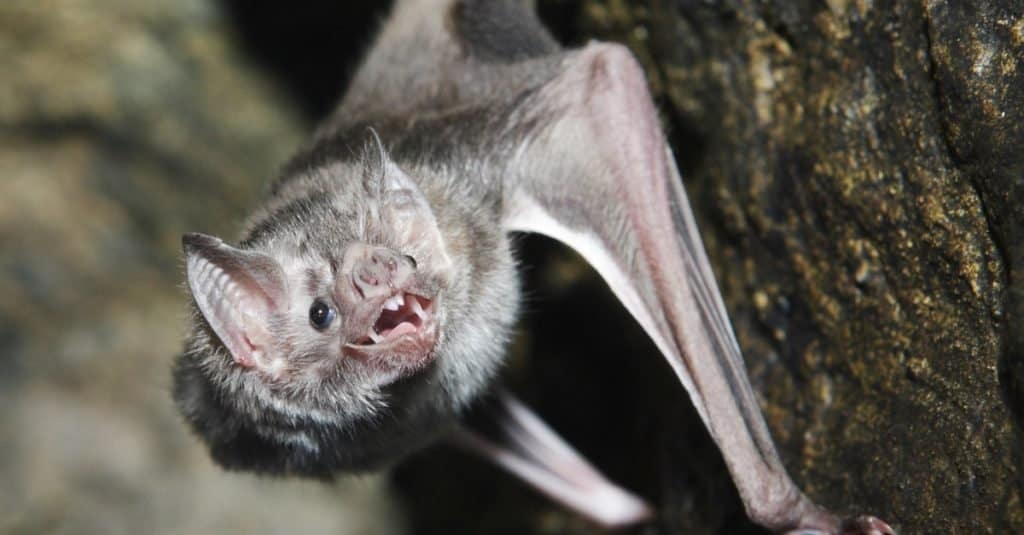
#8: Eurasian Water Shrew
The Eurasian water shrew lives all across northern Eurasia. It burrows into stream banks and makes its home in similar aquatic environments. This venomous mammal has bite saliva that paralyzes its prey. While it can bite or scratch humans with its claws, its small size means that is it not a threat to humans. Weighing in at less than half an ounce and measuring just two to four inches in length, this tiny mammal should still be handled with protective gloves.
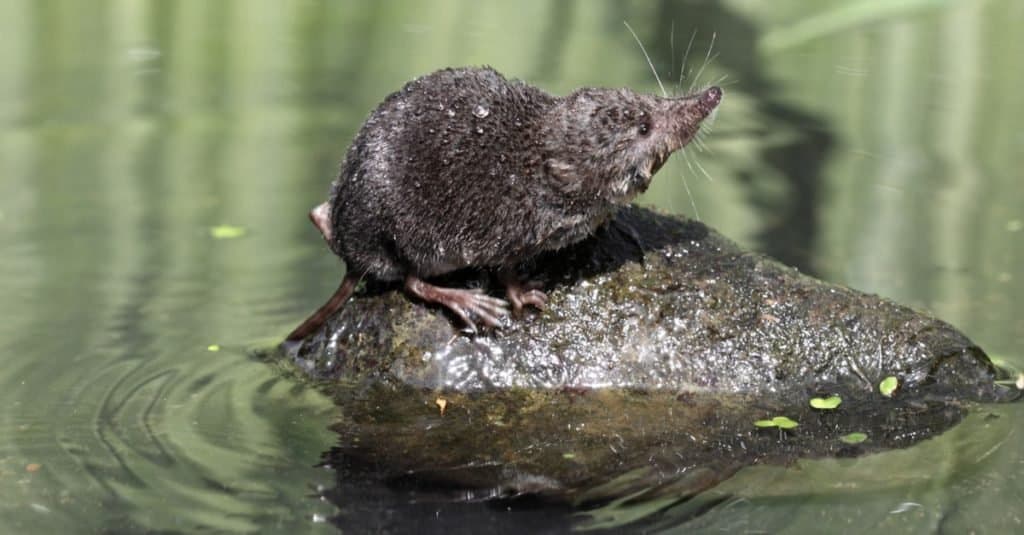
Erni/Shutterstock.com
#7: Mediterranean Water Shrew
Mediterranean water shrews thrive in the waters of the Mediterranean Sea and live in countries that border it such as Spain and Italy. It feeds on fish and other marine life using venom that has paralytic effects. It can administer enough venom in one bite to kill certain fish outright. Slightly smaller than its Eurasian counterpart, the Mediterranean shrew grows to about three inches and weighs under half an ounce.
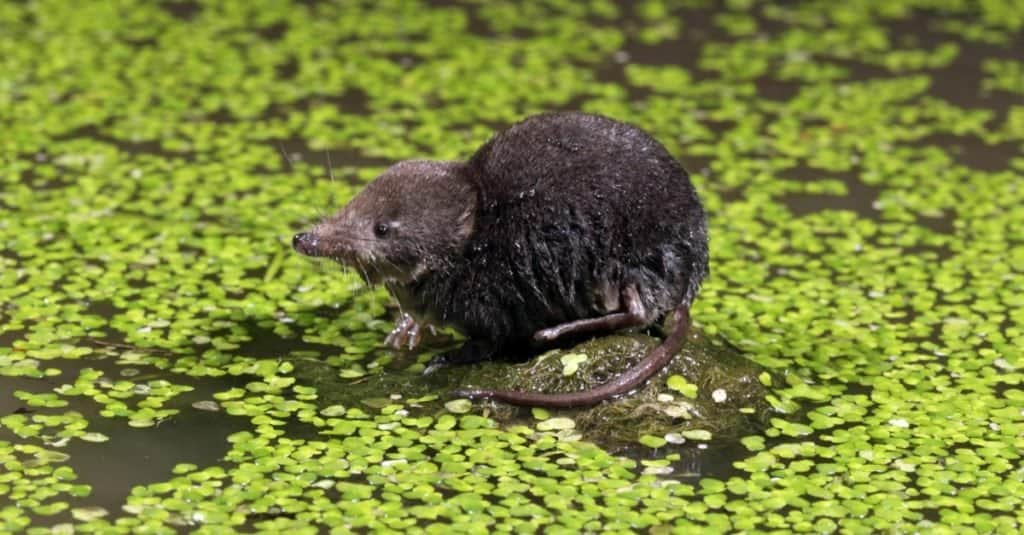
Erni/Shutterstock.com
#6: Short-Tailed Shrews
There are several species of short-tailed shrew that inhabit various parts of the United States and North America. All of these venomous shrew species hunt with venom saturated saliva that has paralytic effects on their prey.
The northern short-tailed shrew lives in the northeast of North America, and Elliot’s short-tailed shrew is a resident of the central United States. Both animals measure up to five inches long and weigh under one ounce.
The southern short-tailed shrew lives in the southeastern United States and the Everglades short-tailed shrew makes it home predominantly in Florida. These venomous mammals grow to be three to five inches in length, but they weigh approximately three ounces. That’s much heavier than their cousins.
These animals all have a conservation status of least concern.

Joe McDonald/Shutterstock.com
#5: European Mole
The European mole earns a higher spot here than the various shrews simply because of its size. An inhabitant of the United Kingdom and Russia, this venomous mammal grows to between four and six inches with a tail that adds another inch, and they weigh about three to five ounces. European moles avoid humans at all costs, but they will inject their victims with a paralytic saliva by biting them when hunting or threatened. These moles drag their prey of mice and rabbits back to their burrows where they will feast on them over time.
Read more about moles here.
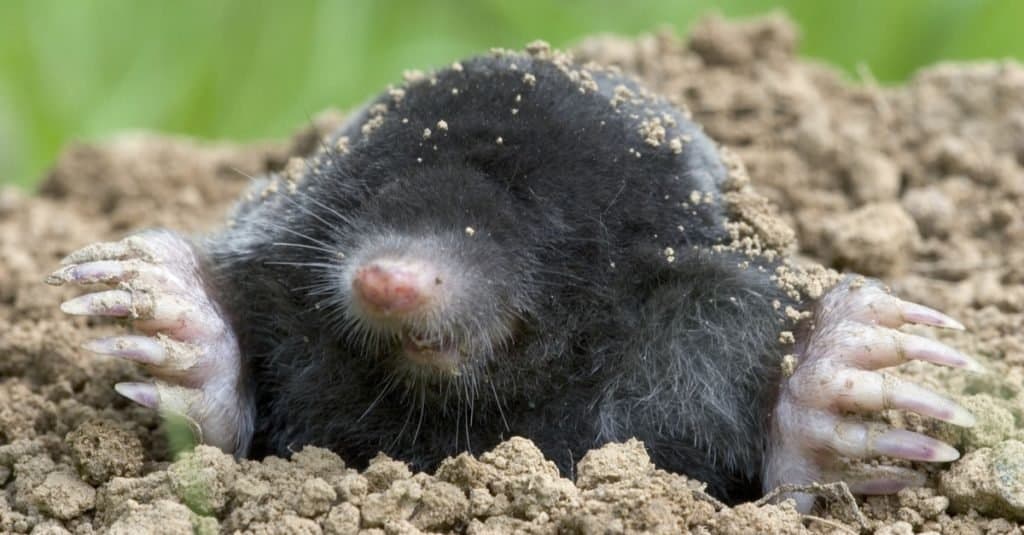
Bildagentur Zoonar GmbH/Shutterstock.com
#4: Cuban Solenodon
As the name suggests, the Cuban solenodon makes its home in the island nation of Cuba. It is a nocturnal insectivore that resides in burrows or hollow trees emerging at night to hunt frogs, reptiles, and small rodents. The Cuban solenodon measures around 16 to 22 inches in length, and it typically weighs less than three pounds. Predation by feral dogs and habitat loss have damaged this population to the point that it is now an endangered species.

Gregory Guida / mindenpictures.com – License
#3: Hispaniolan Solenodon
A cousin to the previous entry on this list, the Hispaniolan solenodon lives on the island of Hispaniola in both Haiti and the Dominican Republic. Possessing slightly more powerful bite saliva than its Cuban relative, this solenodon preys on reptiles, lizards, and insects. Their bites inject venom through their lower incisors that can cause paralysis and death. Weighing in at just under two pounds, this venomous mammal packs a powerful punch in a small package. Due to its small size, the Hispaniolan solenodon does not normally produce enough venom to threaten a human.

#2: Slow Loris
The slow loris is arguably the cutest venomous mammal on this list. There are eight species of primate that can collectively be referred to as slow lorises, but they are all distinct species that inhabit Southeast Asia. Endangered by the illegal pet trade, the slow loris is easily captured and smuggled worldwide, and their passive appearance is a defense mechanism to feeling threatened.
The slow loris possesses sacks beneath its forelimbs that it licks prior to biting. Licking the sack transfers venom to the mouth of the loris that can result in an anaphylactic reaction and death. For this reason, smugglers remove the teeth of the slow loris upon capture which sadly results in infection over 90 percent of the time, and death is common.

hkhtt hj/Shutterstock.com
#1: Platypus
The duck-billed platypus are the most venomous mammal. Its venom is one of the only ones to actually pose a threat to humans. While not fatal, male platypus venom is unbelievably painful to humans, and it can result in lingering pain at the injury site and associated limb for days or even months.
Male platypuses have spurs on their hind legs that can be used to strike when they feel threatened. During mating season, venom sacks grow, and those strikes become truly dangerous as they are now accompanied by a blast of powerful venom. Platypuses are native to Eastern Australia, and they are categorized as a near-threatened species. Read more about the platypus here!
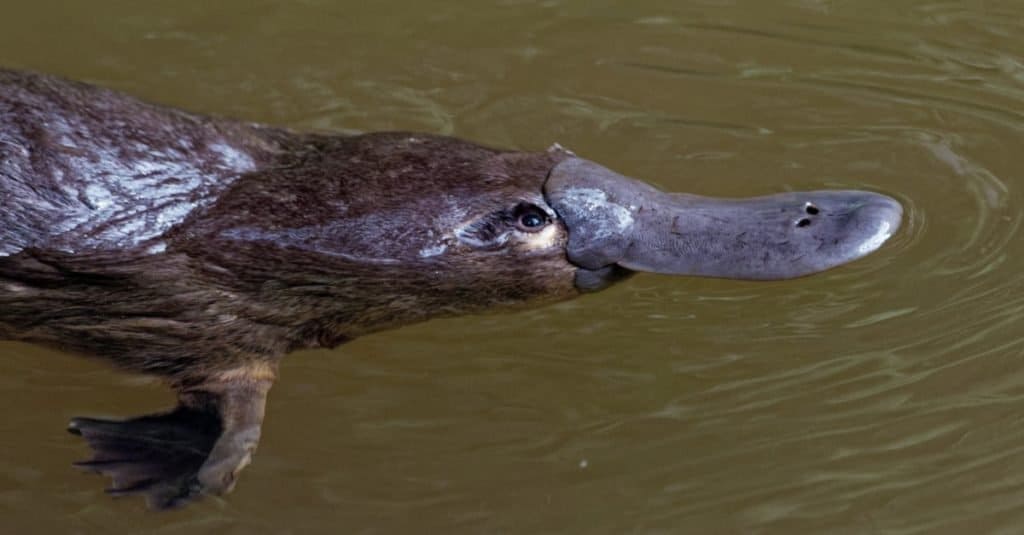
Martin Pelanek/Shutterstock.com
Summary of the World’s Most Venomous Mammals
Let’s recap the mammals that carry venom:
| Rank | Mammal |
|---|---|
| 1 | Platypus |
| 2 | Slow Loris |
| 3 | Hispaniolan Solenodon |
| 4 | Cuban Solenodon |
| 5 | European Mole |
| 6 | Shirt-Tailed Shrew |
| 7 | Mediterranean Water Shrew |
| 8 | Eurasian Water Shrew |
| 9 | Vampire Bat |
| 10 | Maned Rat |
Up Next…
- The 10 Most Venomous Animals In The World! You learned about the 10 most venomous mammals. Now find out about the most venomous animals in the world!
- Can Animals Eat Venomous Snakes Without Dying? Do animals that eat venomous snakes perish? Read on to learn the facts.
- 10 Snakes with Neurotoxic Venom It’s important to be aware of snakes in the wild that are venomous…especially if their venom is neurotoxic.
More from A-Z Animals
Key Points:
- Vampire bats are the only flying venomous mammal. Their venom is not directly harmful in that it doesn’t cause pain or paralysis, but it aids the bat by preventing the blood of its prey from coagulating after the bite.
- Eurasian water shrews, Mediterranean water shrews, and short-tailed shrews all have venom in their saliva when they administer bites to their prey that has a paralytic affect.
- The most venomous mammal on the planet is the duck-billed platypus. Its venom, while not fatal to humans, can cause unbelievable pain at the injury site and associated limb which can last for days or even months.
When most people think of venomous animals, the first things that come to mind are snakes, spiders, and insects. Admittedly, those are the most prevalent venom-carrying animals, but they are not by any means the only ones. Did you know that there are a number of venomous mammals as well?
Venom and poison are frequently used interchangeably, but that is not technically correct. Poison can be absorbed through the skin, inhaled, or taken in through a variety of means, but venom is injected into the body of the attacker or prey via a bite or another method. Keep reading to learn about the top ten most venomous mammals!
#10: Maned Rat
The maned rat holds the last place on this list solely because it is not technically venomous. However, these poisonous mammals defend themselves by injecting those that would prey on them with a poison that is obtained through an interesting method. Native to East Africa, this rat can grow up to almost two feet long with a tail that’s an additional foot in length.
The maned rat searches for poison arrow trees chews on them to release sap from the tree and then rubs its back in the poisonous sap. When threatened, the rat arches its back much like a cat and exposes the poison coated hair. The unwary attacker receives a mouthful of poison which can kill or incapacitate it depending on the size of the animal and the quantity of poison it receives. These poisonous mammals have a conservation status of least concern according to the IUCN.

#9: Vampire Bats
Bats are the only flying mammal, and vampire bats are therefore the only venomous flying mammal. There are several species of venomous vampire bat such as the hairy-legged vampire bat, the white-winged vampire bat, and the common vampire. All venomous species prey on cows, pigs, and other forms of livestock.
Other animals’ blood is the “lifeblood” of vampire bats. In fact, if they go more than two days without it, they die. And their appetites are voracious. In one evening, they will drink up to half their body weight in blood.
Their venom is not directly harmful in that it doesn’t cause pain or paralysis like some of the other mammals on this list, but it aids the bat by preventing the blood of its prey from coagulating after the bite. This allows the vampire bat to satiate itself on free-flowing blood in the bite wound. While their bites aren’t harmful in general, they can cause infection or disease in the victim. Check out more interesting facts about the Central and South American vampire bat species here.

#8: Eurasian Water Shrew
The Eurasian water shrew lives all across northern Eurasia. It burrows into stream banks and makes its home in similar aquatic environments. This venomous mammal has bite saliva that paralyzes its prey. While it can bite or scratch humans with its claws, its small size means that is it not a threat to humans. Weighing in at less than half an ounce and measuring just two to four inches in length, this tiny mammal should still be handled with protective gloves.

Erni/Shutterstock.com
#7: Mediterranean Water Shrew
Mediterranean water shrews thrive in the waters of the Mediterranean Sea and live in countries that border it such as Spain and Italy. It feeds on fish and other marine life using venom that has paralytic effects. It can administer enough venom in one bite to kill certain fish outright. Slightly smaller than its Eurasian counterpart, the Mediterranean shrew grows to about three inches and weighs under half an ounce.

Erni/Shutterstock.com
#6: Short-Tailed Shrews
There are several species of short-tailed shrew that inhabit various parts of the United States and North America. All of these venomous shrew species hunt with venom saturated saliva that has paralytic effects on their prey.
The northern short-tailed shrew lives in the northeast of North America, and Elliot’s short-tailed shrew is a resident of the central United States. Both animals measure up to five inches long and weigh under one ounce.
The southern short-tailed shrew lives in the southeastern United States and the Everglades short-tailed shrew makes it home predominantly in Florida. These venomous mammals grow to be three to five inches in length, but they weigh approximately three ounces. That’s much heavier than their cousins.
These animals all have a conservation status of least concern.

Joe McDonald/Shutterstock.com
#5: European Mole
The European mole earns a higher spot here than the various shrews simply because of its size. An inhabitant of the United Kingdom and Russia, this venomous mammal grows to between four and six inches with a tail that adds another inch, and they weigh about three to five ounces. European moles avoid humans at all costs, but they will inject their victims with a paralytic saliva by biting them when hunting or threatened. These moles drag their prey of mice and rabbits back to their burrows where they will feast on them over time.
Read more about moles here.

Bildagentur Zoonar GmbH/Shutterstock.com
#4: Cuban Solenodon
As the name suggests, the Cuban solenodon makes its home in the island nation of Cuba. It is a nocturnal insectivore that resides in burrows or hollow trees emerging at night to hunt frogs, reptiles, and small rodents. The Cuban solenodon measures around 16 to 22 inches in length, and it typically weighs less than three pounds. Predation by feral dogs and habitat loss have damaged this population to the point that it is now an endangered species.

Gregory Guida / mindenpictures.com – License
#3: Hispaniolan Solenodon
A cousin to the previous entry on this list, the Hispaniolan solenodon lives on the island of Hispaniola in both Haiti and the Dominican Republic. Possessing slightly more powerful bite saliva than its Cuban relative, this solenodon preys on reptiles, lizards, and insects. Their bites inject venom through their lower incisors that can cause paralysis and death. Weighing in at just under two pounds, this venomous mammal packs a powerful punch in a small package. Due to its small size, the Hispaniolan solenodon does not normally produce enough venom to threaten a human.

#2: Slow Loris
The slow loris is arguably the cutest venomous mammal on this list. There are eight species of primate that can collectively be referred to as slow lorises, but they are all distinct species that inhabit Southeast Asia. Endangered by the illegal pet trade, the slow loris is easily captured and smuggled worldwide, and their passive appearance is a defense mechanism to feeling threatened.
The slow loris possesses sacks beneath its forelimbs that it licks prior to biting. Licking the sack transfers venom to the mouth of the loris that can result in an anaphylactic reaction and death. For this reason, smugglers remove the teeth of the slow loris upon capture which sadly results in infection over 90 percent of the time, and death is common.

hkhtt hj/Shutterstock.com
#1: Platypus
The duck-billed platypus are the most venomous mammal. Its venom is one of the only ones to actually pose a threat to humans. While not fatal, male platypus venom is unbelievably painful to humans, and it can result in lingering pain at the injury site and associated limb for days or even months.
Male platypuses have spurs on their hind legs that can be used to strike when they feel threatened. During mating season, venom sacks grow, and those strikes become truly dangerous as they are now accompanied by a blast of powerful venom. Platypuses are native to Eastern Australia, and they are categorized as a near-threatened species. Read more about the platypus here!

Martin Pelanek/Shutterstock.com
Summary of the World’s Most Venomous Mammals
Let’s recap the mammals that carry venom:
| Rank | Mammal |
|---|---|
| 1 | Platypus |
| 2 | Slow Loris |
| 3 | Hispaniolan Solenodon |
| 4 | Cuban Solenodon |
| 5 | European Mole |
| 6 | Shirt-Tailed Shrew |
| 7 | Mediterranean Water Shrew |
| 8 | Eurasian Water Shrew |
| 9 | Vampire Bat |
| 10 | Maned Rat |
Up Next…
- The 10 Most Venomous Animals In The World! You learned about the 10 most venomous mammals. Now find out about the most venomous animals in the world!
- Can Animals Eat Venomous Snakes Without Dying? Do animals that eat venomous snakes perish? Read on to learn the facts.
- 10 Snakes with Neurotoxic Venom It’s important to be aware of snakes in the wild that are venomous…especially if their venom is neurotoxic.






